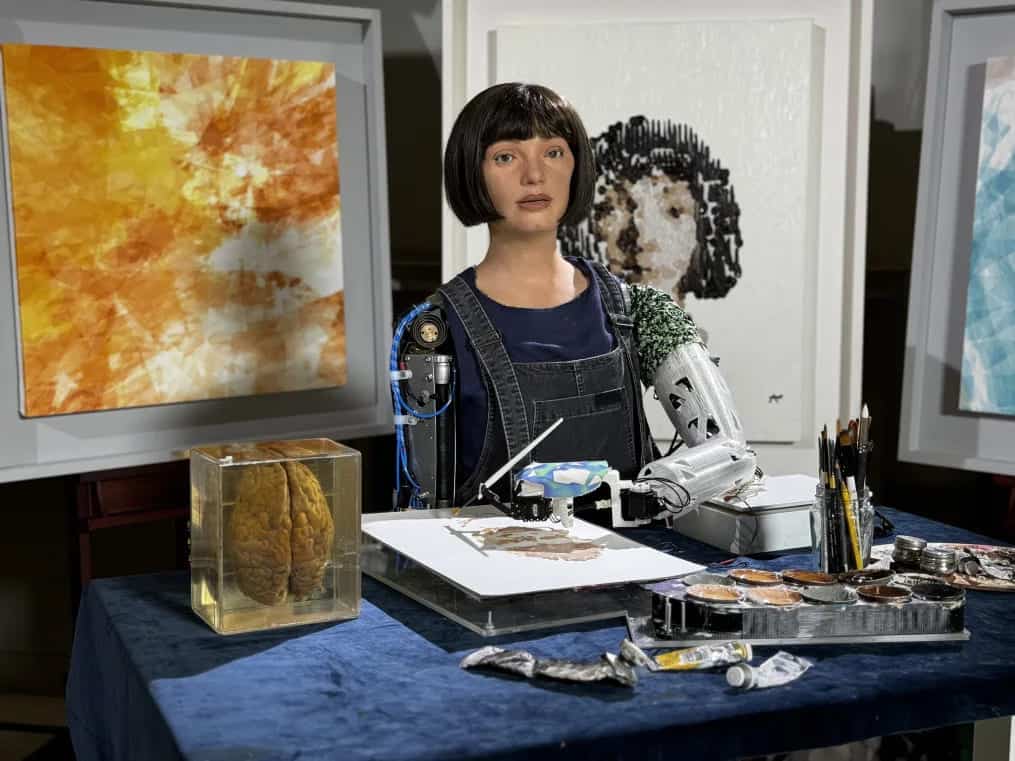As a seasoned crypto investor and lifelong tech enthusiast, I find myself captivated by the digital brushstrokes of Ai-Da, the robot artist. The portrait of Alan Turing she recently unveiled is a testament to the intricate dance between human ingenuity and artificial intelligence—a dance that echoes the ouroboros of technology.
When a robot artist, modeled after humans, creates a portrait of a computer science pioneer, it evokes the symbolism of the Ouroboros in technology – AI honoring its spiritual forefather. The humanoid artist Ai-Da recently revealed her depiction of Alan Turing, who deciphered the Enigma code, laid the foundation for artificial intelligence, and faced persecution for his identity during a less accepting time. The painting, a blend of algorithmic accuracy and creative qualities reminiscent of humans, poses a query: how might Turing perceive this moment? Would he view it as confirmation of his concepts or an unexpected dystopian turn he never foresaw?
Ai-Da, inspired by Ada Lovelace, a pioneer in computer science, employs cameras for eyes, a robotic arm, and algorithms to replicate artistic choices. She operates at the junction of code and canvas, extracting data and patterns to produce abstract yet surprisingly emotive pieces. Her depiction of Turing goes beyond being just an exploration in computational aesthetics; it represents a conversation across generations, between a man who questioned, “Can machines think?”, and a machine that responds, “I can create.

Art, Algorithms, and Alan
Let’s avoid exaggerating the comparison. Ai-Da isn’t a contemporary equivalent of Leonardo da Vinci. Instead, her “creativity” is shaped by artificial neural networks and human developers. However, here’s an interesting point: Turing proposed that if a machine could make a person believe it was thinking, then it was thinking, full stop. Ai-Da doesn’t merely exist; she provokes us to reconsider the boundaries of creativity, consciousness, and ultimately, what it means to be human.
The depiction of Alan Turing in Ai-Da’s artwork is poignantly haunting. The lines are carefully crafted but broken, mirroring the life of Turing – bright with genius yet scarred by sorrow. The color scheme predominantly features muted blues and grays, suggesting both the icy rationality of machines and the melancholy of a misunderstood genius shunned by society. Ai-Da seems to be capturing Turing’s inner realm through her synthetic lens, paying tribute to a man whose influence she carries forward.
Turing’s Vision vs. Our Reality
In 1950, Turing envisioned machines capable not only of computation but also of reasoning. Fast forward to 2024, we’ve created machines that can outwit chess masters, converse like humans, and even challenge artists in creativity. Ai-Da embodies this dream, yet she also underscores its potential dangers.
Is it possible that Turing would find himself both elated by the confirmation of his ideas and alarmed by their impact on modern surveillance systems and data-collecting enterprises? The emergence of Ai-Da represents a complex situation. On one side, she’s an incredible achievement demonstrating our progress. On the other hand, she serves as a warning sign for the ethical dilemmas we are eagerly plunging into. Who holds the rights to the art that Ai-Da produces? Can a robot truly possess intellectual property? And if we deem Ai-Da an artist, are we inadvertently undervaluing human creativity?

The Turing Test of Art
As an analyst, I ponder over the original design of the Turing Test, which aimed to assess a machine’s capability to mimic human-like intelligence. However, it leaves unanswered questions regarding creativity. Perhaps, AI-Da is paving the way for a novel test: can machines create art that stirs our emotions, alters our understanding of reality, or expresses a profound emotional truth?
Perhaps the solution you’re seeking is at hand. Ai-Da’s depiction of Turing doesn’t merely copy traditional art styles; it challenges. It compels us to grapple with the heritage of a man who made machines capable of thought, and the machines that are now contemplating his own creation. The outcome is a portrait not only of Turing, but of humanity’s complex relationship with the technology we’ve brought forth.
A Post-Human Renaissance?
Should Turing be credited for laying the intellectual groundwork for artificial intelligence, then AI-Da stands as one of its cultural landmarks. While her work may not possess the emotional depth of a Van Gogh or the technical finesse of a Vermeer, it’s not intended to. Instead, it serves as a declaration: machines are no longer mere tools, but contributors to our cultural development. Whether this idea sparks excitement or unease depends on one’s comfort level with the notion that creativity might not be exclusive to humans.
Turing’s portrait is a mirror held up to the digital age, reflecting both our potential and our anxieties. In Ai-Da, we see a piece of Turing’s legacy brought to life, pixel by pixel, brushstroke by robotic brushstroke. The question isn’t whether this is art. It’s whether we’re ready to share the gallery with our synthetic siblings.
Troy Miller is a tech columnist who enjoys unraveling the messy intersections of humanity and technology. His sarcasm is 100% organic.
Read More
2024-11-10 21:08